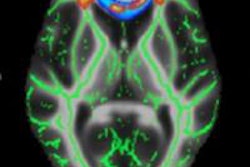
CHICAGO - Diffusion-tensor MRI (DTI-MRI) showed measurable changes in the brain's white matter in high-school football players after just one season, even though there were no signs of concussion among the athletes, according to a study presented on Monday at RSNA 2014.
The study, led and presented by Dr. Christopher Whitlow, PhD, an associate professor of radiology at Wake Forest School of Medicine, indicates that these players are at greater risk of brain abnormalities over just a few months of repeated hits to the head, potentially delaying brain development during their adolescent years.
 Dr. Christopher Whitlow, PhD, from Wake Forest School of Medicine.
Dr. Christopher Whitlow, PhD, from Wake Forest School of Medicine."This is probably the biggest and most comprehensive investigation to date of youth and high-school-related football head impact," Whitlow told AuntMinnie.com. "The majority of biomechanical imaging research has focused on the collegiate and professional level, despite the fact that more than 70% of football players play at the youth level. Little is known about youth exposure to multiple repeated head impacts."
The researchers evaluated 24 high-school football players who were between the ages of 16 and 18. The players were fitted for all games and practices with special helmets mounted with head impact telemetry (HIT) accelerometers. The devices are used in youth and college football to assess the frequency and severity of helmet impacts.
From the HIT data, the researchers calculated risk-weighted cumulative exposure (RWE) of head and helmet impacts and the risk of concussion over the course of the season. Total impacts and RWE were also used to categorize the players as heavy or light hitters. There were nine heavy hitters and 15 light hitters, according to Whitlow and colleagues.
Diffusion-tensor images were acquired before and after the season on a 3-tesla MRI scanner (Siemens Healthcare). DTI-MRI is used to measure the movement of water molecules along millions of nerve fibers, called axons, which make up the brain's white matter. The measurement is known as fractional anisotropy.
In healthy white matter, the direction of water movement is fairly uniform and results in high fractional anisotropy values. When water movement is more random, fractional anisotropy measurements decrease, suggesting that there might be some microstructural abnormalities.
"These fibers are parts of the brain that change over time, particularly in the adolescent brain," Whitlow said.
DTI findings
In their analysis of the images, the researchers found that both the heavy-hitter and light-hitter groups demonstrated increases in fractional anisotropy before and after the season, likely due to the effects of adolescent brain development.
However, the heavy-hitting football players showed statistically significant decreases in fractional anisotropy after the season in specific areas of the brain, including the corpus callosum and deep white-matter tracts. The players did not show any symptoms or signs of clinically diagnosed concussion.
"It is important to put that into perspective," Whitlow said. "We are not saying that we are seeing any kind of damage. We are talking about changes that we are seeing, and, in our minds, these changes are concerning because the players with the most head impact exposure had the most changes and the players with the least head impact exposure had the least changes."
The results raise concerns about potential white-matter injury or delayed brain development because similar MRI changes in previous research have been associated with mild traumatic brain injury, Whitlow and colleagues added.
"Therefore, the question is: What do these changes mean? We don't know yet," Whitlow said. "We are seeing these changes, and they are related to head impact exposure, so it is concerning. But in terms of the exact meaning, we have to do more work to figure that out."
The purpose of the study is to try to make football safer for all players, he said. "If we can identify the risk, then it becomes perhaps a more simple problem to intervene and correct," he explained.
The group plans to extend the research, depending on future funding from sources such as Wake Forest's Childress Institute for Pediatric Trauma, which supported the current study.
"One component of [future research] is to follow these players longitudinally and look more carefully at their cognitive function, since we have that data as well," Whitlow said. "We want to follow them as long as we can and certainly pursue additional support from the National Institutes of Health."



.fFmgij6Hin.png?auto=compress%2Cformat&fit=crop&h=100&q=70&w=100)




.fFmgij6Hin.png?auto=compress%2Cformat&fit=crop&h=167&q=70&w=250)











